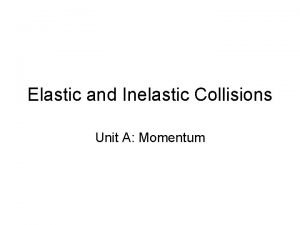Inelastic Neutron Scattering INS A Novel NonDestructive Soil

- Slides: 1

Inelastic Neutron Scattering, INS, A Novel Non-Destructive Soil Carbon Analysis System; I - Principles L. Wielopolski, S. Mitra, O. Doron 1 Brookhaven National Laboratory, Environmental Sciences Department Upton, NY 11973 lwielo@bnl. gov Principle: INS is based on spectroscopy of gamma rays induced by nuclear interaction of fast neutrons with elements present in the soil matrix. The fast 14 Me. V neutrons are produced by a pulsed neutron generator that induce 4. 44 Me. V carbon gamma rays detected by an array of Na. I detectors. Shielding Neutron Interactions With Matter De te * Delayed ct Sh i or s el di ng H 2 O Neutron Generator Al Prompt Particle Activation (n) + n+z A z n+z+1 A z Fast Neutrons 30 cm (n, ) (n, x, ) , n’, , 2 n, , p, , , , Elements measured in situ: H, N, C, O, Na, Cl, Si, Ca, Fe, Ti, Gd, S, Al, K, U, Th INS Gammas Prompt Gammas Delayed Gammas C, O, Si, Mg H, N, Si, S, Ca, P Na, Cl, Ca, Al, K γ n (n, n’γ) Interaction Site Soil 0 ~ 500 μsec Neutron Thermalization via Elastic Scatterings and Thermal Neutron Capture 25 sec ~ 0. 001 to ∞ sec Delayed Activation Following Neutron Capture 75 sec Gamma ray spectra following neutron inelastic scattering (on the left) and thermal neutron capture (on the right) showing carbon and nitrogen peaks respectively. These spectra are acquired concurrently into two separate memory bins. INS System Response Function; Solved using Monte Carlo method φn(x, y, z, E) Surfaces describing CN = k∫dt ∫ ∫∫∫φn(x, y, z, E)σ(E)Cc(x, y, z)ρb(x, y, z)Ω(x, y, z)· At(x, y, z)Det(x, y, z)d. Edxdydz the volumes from T E V which a 90, 95 and 99% of the carbon gamma rays signal CN in units of [C net counts/(g. C/cm 2)/sec/n] intercepts the detectors. z Cc(x, y, z) z Neutron Profile Bulk Density Ω(x, y, z) z z z Carbon Profile Atc(x, y, z) ρb(x, y, z) Signal Attenuation Solid Angle The INS Capabilities • Due to nuclear interactions the INS system measures specifically elemental carbon independent of chemistry. • The system sees constant volume, about 0. 3 m 3. • The INS signal is linear with carbon abundance in a given volume. • Due to very fast interaction times the system can be used in a stationary or continuous scanning modes at approximates speed of 10 km/h. • INS provides multielemental quantitative analysis for C, N, K, P, and others elements. • It is rapid, in situ, and non-destructive thus enabling true sequential measurements. • Can be adapted for non-destructive carbon depth profiling or monitoring carbon changes in a given depth interval. % of Total Depth Footprint Volume Mass Response (cm) (m 2) (m 3) (kg) 90 25 2. 400 0. 233 325. 66 95 31 3. 345 0. 373 522. 18 99 44 7. 069 0. 789 1105. 29 INS Alpha prototype for field measurements

